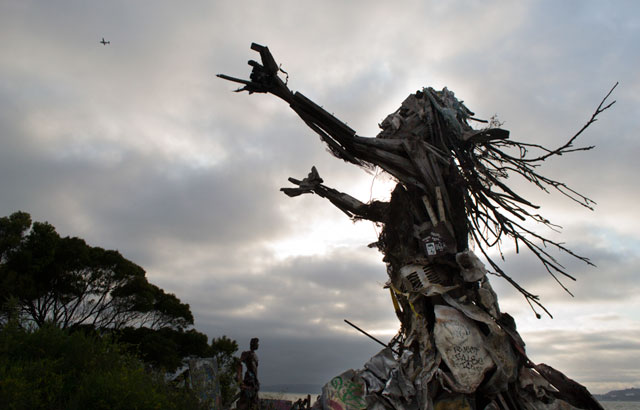Advocates for the encampment on the Bulb argue it is part of the local community, and that there should be better plans in place for the homeless after they are evicted.
"Apart from the incredible loss to the people who are living there and the threat to them and the fact that they're going to lose their home, what all of us are going to lose is that model of coexistence, of an ecology that includes humanity in it," said Osha Neumann, an East Bay attorney who has represented some Bulb residents. He doesn't want the city to clear the camp without making sure the homeless have somewhere else to go.
The camp's population has ebbed and flowed over the years. It reached a high point of around 60 in the late 1990s, when Albany enacted a no-camping ordinance and evicted Bulb residents in 1999.
Meanwhile, concerns about landfill-tainted drainage, or leachate, stalled the transfer to the park district. At some point, Albany stopped enforcing the no-camping ordinance, and tents and shacks again sprouted in the bushes.
The people who live on the Bulb don't consider themselves homeless. Some claim to have resided there for more than 10 years, and the ones who say they've lived there for years consider it their home. Many say police found them sleeping on the street in Albany or Berkeley and encouraged them to move to the camp, but the cities dispute that would ever happen.
In May, Albany contracted nonprofit Berkeley Food and Housing Project for $60,000 -- or about $1,000 per camp resident -- to connect the people on the Bulb with services and, hopefully, new housing. The campers say they've talked to the outreach workers, but those with a little income from Social Security or other sources worry they won't be able to afford a place to live that is as safe as the camp.
That's Steve Courie's situation. The 63-year-old blues musician says he's getting too old to camp, and he's too tired for a political fight. But he marched to the Albany City Council meeting on Sept. 3 with about 20 other Bulb residents anyway, hoping to convince council members to reverse their eviction plan.
"If we lose this, the ones that don't make it into a house or whatever are going to end up sleeping in business doorways and stuff like that," Courie said. "It's not a pretty picture."
The council voted 4-1 to have police begin enforcement of the no-camping ordinance sometime in October. Council members say letting the camp continue will only make the problem worse.
"This situation is not going to get better -- it's only going to get worse," said Cheasty. "We can't require that we solve all problems in our society before we have a park. It just doesn't work that way. We have a shoreline park. No one's allowed to privatize it."
Some Albany residents say they're afraid to go to the Bulb as long as the camp is there.
"I'm actually one of those people who used to go down there," said Patricia Jones, executive director of Citizens for East Shore Parks, "but I wouldn't go down there alone right now. We're really looking for this to be a positive change -- that these people will be helped and that the park will be returned to the rest of the people."
Neumann doesn't think Albany's $60,000 effort will actually result in housing anybody and said the Bulb campers likely will be kicked to the streets in October.
"They don't have a shelter, they don't have a transitional house, they don't have a single unit of low-income subsidized housing," he said. "It's taken years to create this situation. You can't unravel it in three or six months at the beginning of winter, and they know that. And they don't care."
Housing in Albany is an additional layer to the controversy. The city is overdue in submitting an acceptable housing element of its general plan to the California Department of Housing and Community Development. State law now requires jurisdictions to have at least one zone allowing emergency shelters without a conditional use permit, and Albany's current zoning only allows for conditional use. Conditional use means a prospective emergency shelter would have to go through an additional approval process, which is forbidden by state law.
Albany could contract with a neighboring city to fulfill its obligation. City officials say they are working on the plan. The city's planning and zoning commission has scheduled a work session for the housing element of its general plan for Sept. 25 at 6:30 p.m.
Listen to the audio report:
